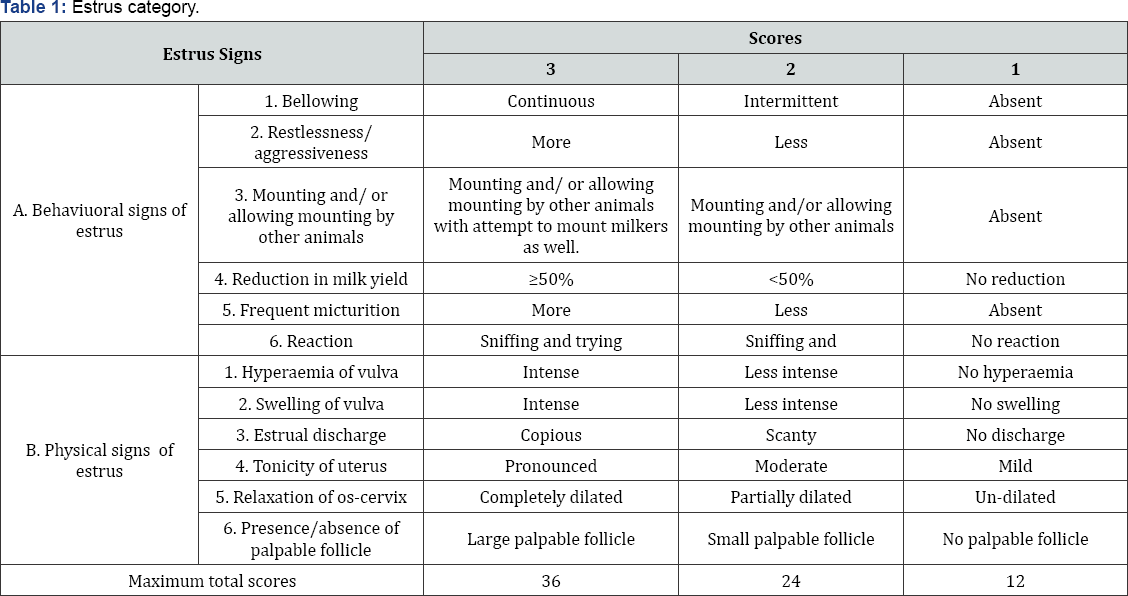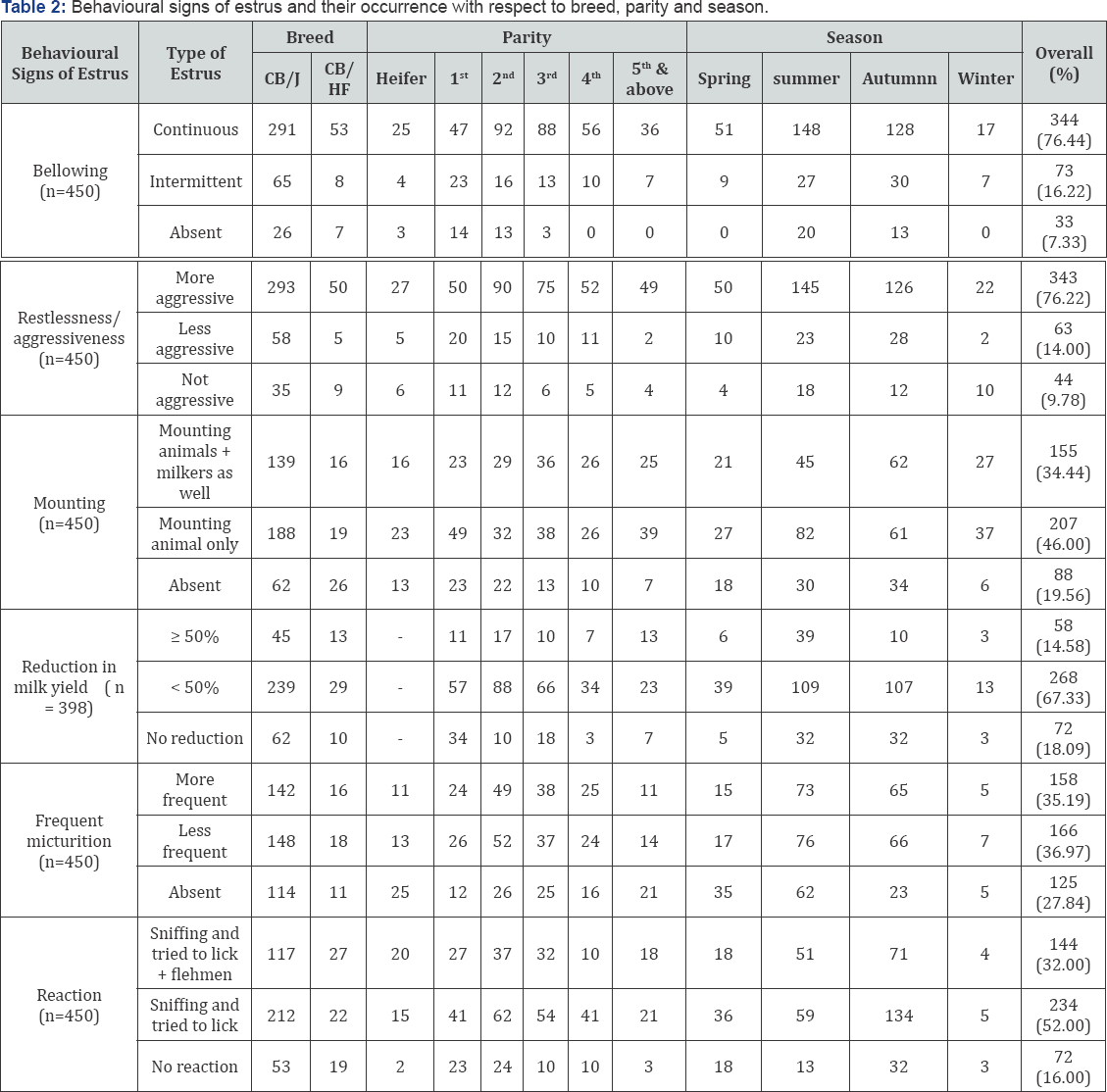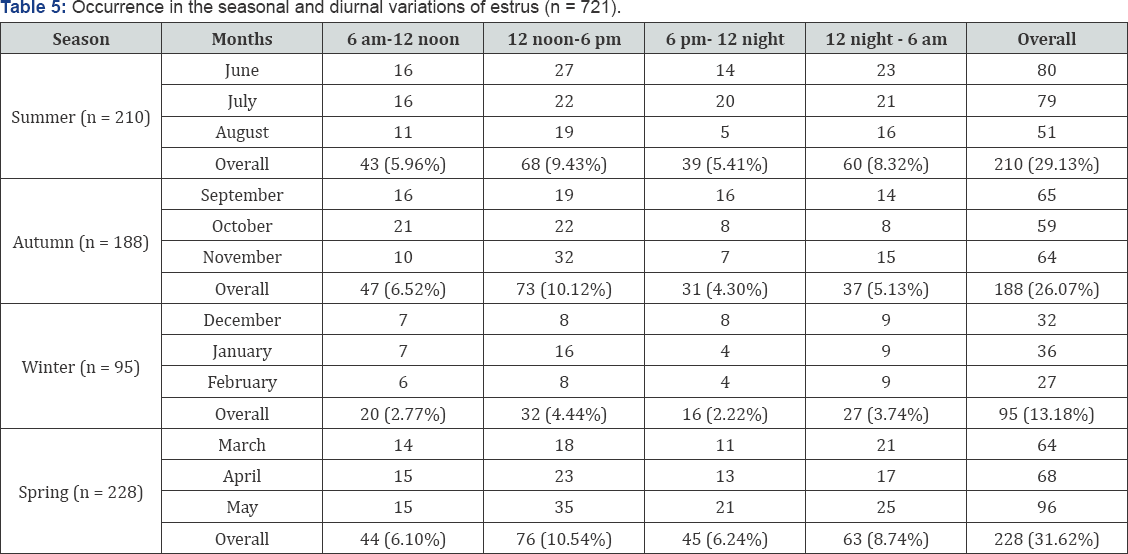Estrus and Estrus Behaviour and their Effect on Conception Rate in Crossbred Cows of Temperate Region of India-Juniper Publishers
JUNIPER PUBLISHERS-OPEN
ACCESS JOURNAL OF DAIRY & VETERINARY SCIENCES
Abstract
A total of 758 apparently healthy cattle represented in the nearby villages of the Faculty clinics and were also brought for insemination to the clinics was used to study behavioral and physical signs of estrus, diurnal variations in the occurrence of estrus and the effect of estrus intensity on conception rate (CR). Bellowing (92.67%) and restlessness/aggressiveness (90.22%) were found as most appreciable behavioral signs while, most appreciable physical signs of estrus recorded were tonicity of uterus (100%), hyperemia of vulva (94.67%) and relaxation of OS-cervix (89.17%). Significantly lower number of animals (13.18%) showed estrus in winter as compared to other seasons. Diurnal variation in the occurrence of estrus in different months and season of the year was found non-significant. Irrespective of the seasons maximum number of animals showed estrus, during 12 noon to 6 pm. Overall CR was recorded as 70.00% with the significantly highest being in animals showing good estrus (75.22%) followed by moderate (60.26%) and weakness (56.25%) estrus respectively.
Keywords: Behavioural and physical estrus signs; Estrus intensity; Diurnal variations in estrus occurrence; Conception rate; Crossbred cows; Kashmir
Introduction
Artificial insemination (AI) is greatly dependant on efficient and successful heat detection that reduces extended periods of calving. To maintain an ideal 12-13 months calving interval, cows must be pregnant by 100 days after calving. As a guideline, 90% of the cows should have been observed in heat by 40-50 days after calving. It costs more than Rs. 300.00/- day to feed and house a dry cow. If the calving interval is 390 days instead of 365 days in a 100 cow herd, this added cost will approximately be $7500/ year [1]. Inadequate estrus detection leads to missed breeding and low conception rate (CR). Improved estrus detection practices allows for heifers and cows to be bred artificially with genetically superior sire and also to achieve optimum calving interval. However, no estrus detection aid can ever completely substitute for the keen, conscientious observer. Therefore, close visual observation is very much required in efficient estrus detection [1]. Although there are anecdotal reports of improving CR of dairy cows, yet the actual outcome of such research has not been undertaken under field conditions particularly in India. The present study was thus undertaken to unravel different behavioural and physical signs of estrus and their effect on CR in crossbred cows of Kashmir, a temperate region of India.
Materials and Methods
A total of 758 apparently healthy cattle represented in the nearby villages of the Faculty clinics and were also brought for insemination to the clinics constituted the material of the present investigation. Bellowing, restlessness, aggressiveness, mounting, reduction in milk yield, frequent micturition, and reaction of the estrus cows shown when loaded AI gun (with semen straw) was placed in front of her nose for a few seconds, were recorded as behavioural signs of estrus. Behavioural signs were recorded from the history given by the owner and/ or from the continuous observation of these cows for about 30 minutes. Hyperaemia of vulva, swelling of vulva, quality of estrual discharge, tonicity of uterus, relaxation of os-cervix and presence or absence of palpable follicle were considered as physical signs of estrus and were recorded by physical and per-rectal examination of the reproductive tract. Estrus signs were recorded with respect to breed, parity and season. Season comprised of winter (December-February), spring (March-May), summer (June-August) and autumn (September-November). These twelve signs of estrus were assigned scores from 1 to 3 (Table 1) in ascending order. Every animal was given a total score of 12-36 determined after adding individual values of various estrus signs. Depending upon the individual total scores, estrus was categorized as good, moderate and weak with a total score of 31-36, 19-30 and 12-18 for respective category. Insemination to the animals found in estrus, was carried out with frozen thawed semen having at least 50% post-thaw motility and 30 million spermatozoa per dose by a single gynaecologist using traditional thumb (am-pm) rule of insemination. The CR was determined with respect to type of estrus and was compared with Pearson's chi-square test [2].

Results and Discussion
Out of 758 cattle presented for AI, 721 cows were found actually in estrus. Merely 5% (4.88%) animals were not found in estrus at the time of presentation of these animals. This reflects good literacy amongst the people of this locality regarding estrus detection of their cows.
Behavioural Signs of Estrus
Different behavioural signs of estrus and their occurrence have been depicted in (Table 2). In the present study, bellowing and restlessness/ aggressiveness were found as most appreciable signs of estrus which were recorded in more than 90% cases (Table 2). Mounting and/ or allowing mounting by other animals were observed in about 80% animals, of which some (34.44%) animals were so aggressive that they tried to mount milkers as well. Earlier reports indicated that bellowing, mounting and restlessness are most frequently observed signs of estrus [3]. [1] reported that standing heat or allowing to mount other cows when she stands is the most reliable heat sign; however, all riders are not necessarily in heat. Moreover, 5% of all pregnant cows and heifers also stands immobile when mounted by herdmates or by a bull. Reduction in milk yield and frequent micturition were observed in 81.91 and 72.16% cases respectively. Eighty percent estrous animals showed either sniffing and trying to lick (52%) the AI gun or sniffing and trying to lick the gun with peculiar flehmen posture (32%) when loaded AI gun with semen filled straw was placed in front of her nose. This might be due to receptive stage of the cow as she desires to mate.

Physical Signs of Estrus
Various physical signs of estrus and their occurrence have been shown in Table 3. The most appreciable physical signs of estrus recorded was tonicity of uterus (100%) followed by hyperaemia of vulva (94.67%) and relaxation of OS-cervix (89.17%) [4] reported that uterine tonicity and relaxation of OS- cervix ate two important physical indicators for measuring estrus intensity in cows. Swelling of vulva was recorded in 88.89% cases. Vulva generally remains wrinkled or occasionally becomes smoother in non-estrous cows. Stringy clear mucus discharge can also be seen in the gutter or on the ground where an estrous cow had been resting (Keown and Kononoff, 2007). In this study, estrual discharge was recorded either copious (36.22%) or scanty (14.89%) in 63.78% cases together and in remaining 36.22% cases no discharge was found. Sometimes discharge came out during manipulation of reproductive tract by per-rectal examination. In most of the cases, scanty to no discharge was recorded in the animals which were examined after 14-16 hours from the onset of behaviuoral estrus; while as copious discharge was found in those animals, which were examined within 12 hours of estrus. This supports the earlier observation in cow [5] and goat [6] that estrual discharge is copious in early estrus and scanty or absent in late estrus. Follicle could be palpated only in 66.83% cases. By naked hand whether a follicle can be palpated or not that depends on the stage of estrus. In an animal where follicle is not palpated during early estrus, it may be palpated in the same animal which is examined during late estrus. In our study, follicle could be palpated in 81.91% (326/ 398) cases when another second examination was carried out 24 hours after the first. Moreover in delayed ovulators there is very less chance that follicle is palpated in early estrus.

Seasonal and Diurnal Variation of Estrus
Significantly lower number of animals (13.18%) showed estrus in winter as compared to other seasons. Although animals showing estrus in spring, summer and autumn season were varied, but statistically there was no significant difference amongst these three seasons (Table 4). Under agro-climatic condition of Kashmir cattle are stall-feed during winter and there is no supply of green fodder in this period leading to reduced intake of vitamins and minerals. These factors could lead to occurrence of various reproductive disorders including anestrum [7]. Moreover extreme cold can directly affect reproductive capacity of animals [8]. Similar to the condition of summer infertility in buffaloes as observed in some hot parts of India during summer, reproductive capacity of animals also becomes lowered down in Kashmir during winter, as such an appropriate term for the condition 'winter infertility' may be used for the condition.

No drastic variation was observed in diurnal variation animals showed estrus during 12 noon to 6 p.m. In rural Kashmir of estrus during different months and season of the year; it has been observed that during this time (12 noon to 6 p.m.) however, irrespective of the seasons maximum number of all family members are available at their residence giving ample opportunity for close watching of their livestock and there by efficient heat detection, which is not possible in rest of the time due to either reluctance at night time or non-availability of members in morning half of the day. So proper education to the farmers is necessary regarding close observation of their estrous cows and there by having ample opportunities for breeding of those cows. Earlier report indicated that estrus can be influenced by season of the year with more cows showing heat at night during hot weather and more heat at day during cold weather [1].

Effect of Estrus Intensity on CR
Overall CR was recorded as 70.00% and was almost similar to the earlier findings in this locality [3]. This value was higher than one reported in Hariana breeds of India. However, overall CR as high as 82 to 91 % was also reported in pure Holstein cows in Canada [9] . The cows included in our study belonged to uneducated rural farmers; so high CR observed in well organized farm is not expected here. Significantly higher CR (P: 0.017) was observed in animals showing good estrus (Table 5). Low CR was found in animals showing both moderate and weak estrus [10] recorded 0, 14.74 and 42.42% CR in animals showing weak, moderate and intense uterine tone respectively.
From the study it can be concluded that, bellowing (92.67%), restlessness/aggressiveness (90.22%) and mounting and/ or allowing mounting by other animals (80.44%) were found as most appreciable behavioural signs of estrus. The most appreciable physical signs of estrus recorded were tonicity of uterus (100%), hyperaemia of vulva (94.67%) and relaxation of os-cervix (89.17%). Significantly lower number of animals showed estrus during winter season as compared to other season of the year. Highest CR was recorded in the animals showing good estrus (75.22%) as compared to either moderate (60.26%) or weak (56.25%) estrus.
For more Open Access Journals in Juniper Publishers please click on: https://juniperpublishers.com
For more articles in Open Access Journal of Dairy & Veterinary sciences please click on: https://juniperpublishers.com/jdvs/index.php
For more Open Access Journals please click on: https://juniperpublishers.com
To know more about Juniper Publishers please click on: https://juniperpublishers.business.site/


Comments
Post a Comment